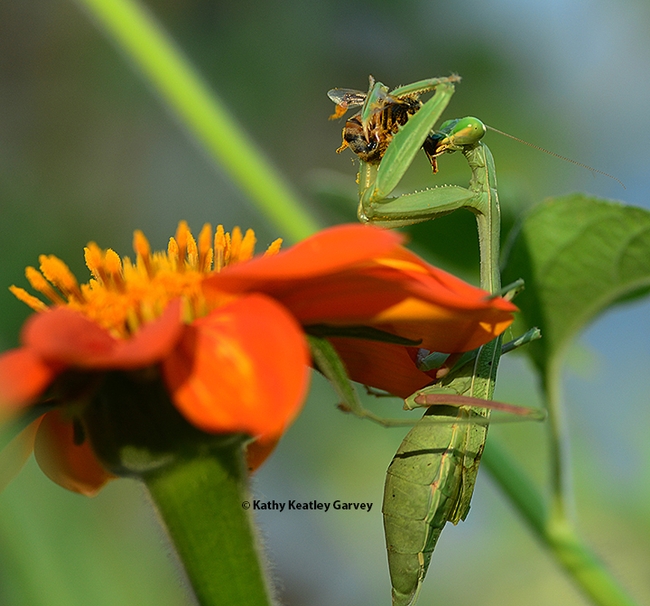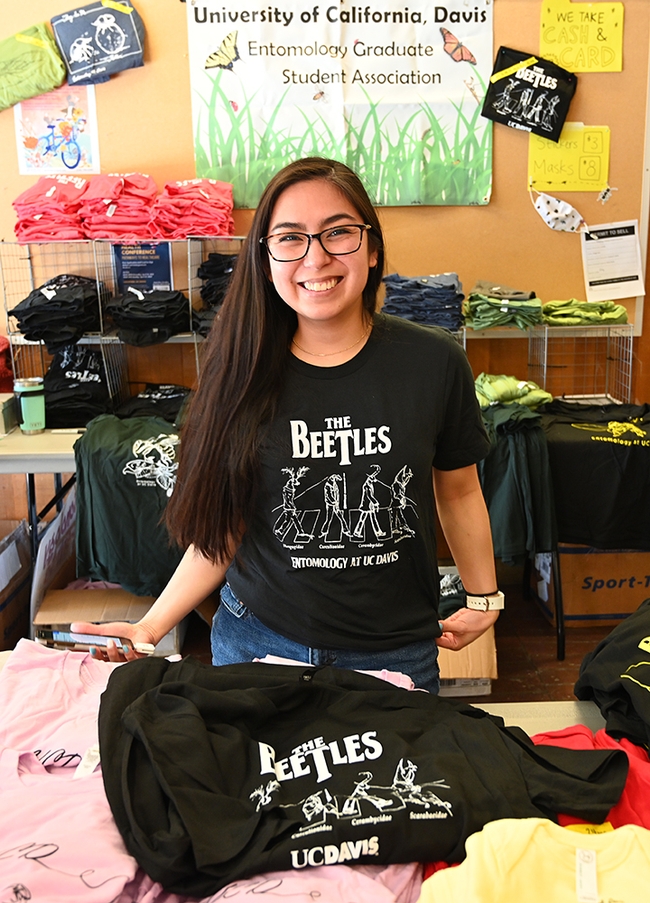- Author: Kathy Keatley Garvey
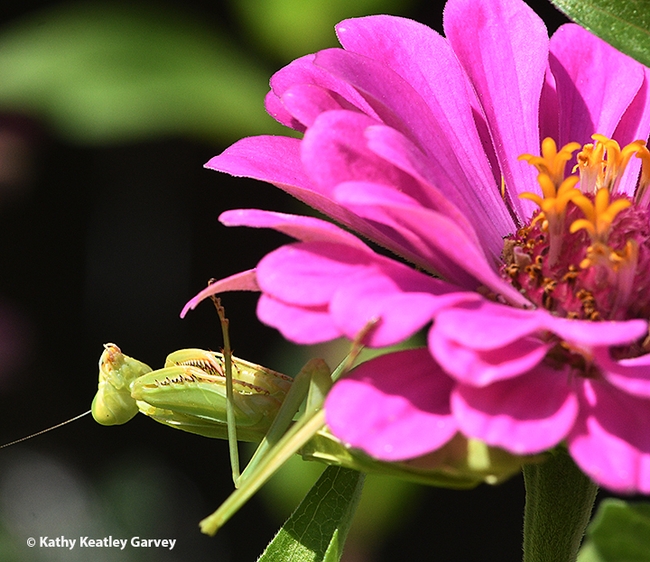
Often it's so camouflaged that it totally blends in with its habitat. It can rotate its head 180 degrees--and nothing, it seems, can escape its view.
Praying mantises are not considered biological pest control agents because basically they'll eat anything they can catch: from your favorite pollinators (bees and butterflies) to your favorite beneficial insects (lady beetles and assassin bugs), your favorite bird (hummingbird) to pests (stink bugs and lygus bugs) to syrphid flies, green bottle flies, and wandering caterpillars that happen to cross its path.
And they'll eat one another...catch me if you can!
Truly, they are not picky eaters like little humans who scowl at a food, push it around their plates, or "accidentally" drop it on the floor for the dog to grab.
"Over 2,000 mantid species occur in the world, mostly in tropical and subtropical regions," according to the UC Statewide Integrated Pest Program (UC IPM). "At least 9 mantid species occur in California. The Arizona or bordered mantid (Stagmomantis limbata), Bistanta mexicana, California mantid (Stagmomantis wheeleri =S. californica), Litaneutria ocularis =Litaneutria obscura, and small gray mantid (Litaneutria pacifica) are native species. Chinese mantid (Tenodera sinensis), European mantid (Mantis religiosa), Mediterranean mantid (Iris oratoria), and South African mantid (Miomantis caffra) are introduced."
"Mantids (mantises) are among the largest insects," UC IPM says. "Adults generally range from 2 to 5 inches (5–12 cm) long. Adults and nymphs (immatures) are elongate and usually brown, green, or yellowish; a single species can have all 3 color phases, such as the California mantid, Stagmomantis wheeleri =S. californica."
A mantis has two spiked forelegs that enable it to grasp and subdue its prey. It's a death grip...or a dinner grip...Ever seen a praying mantis "cradle" its prey?
This mantis, below, is a Stagmomantis limbata. Dinner was a bee. Earlier it preyed on a green bottle fly.
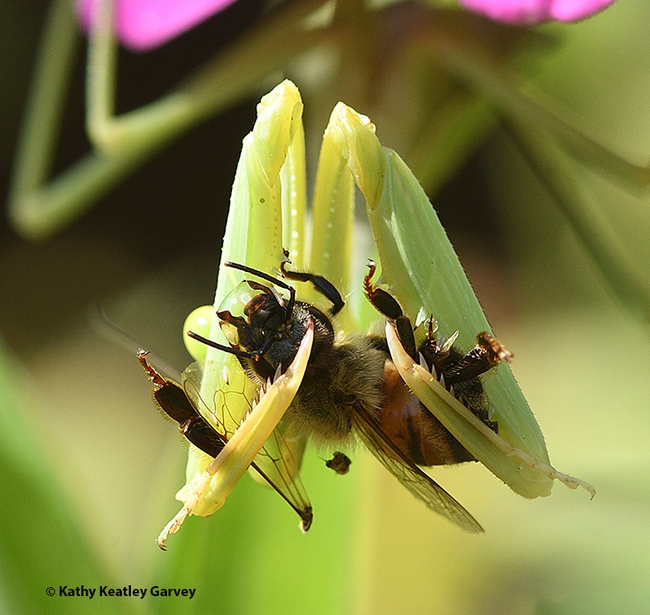
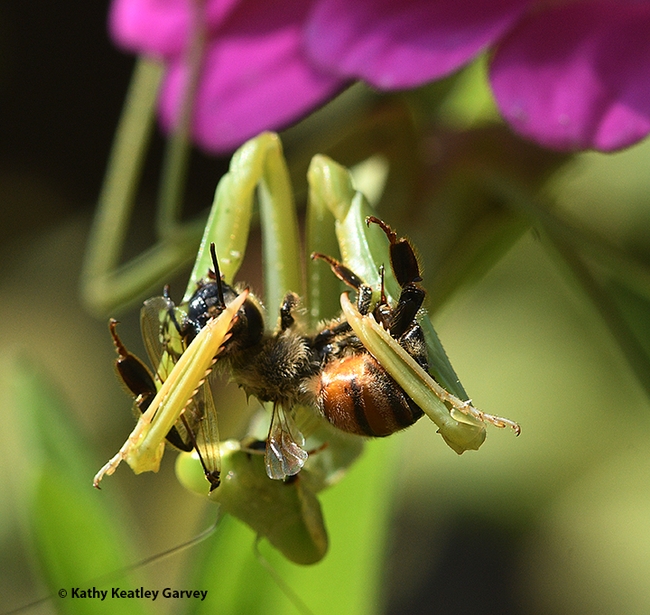
- Author: Kathy Keatley Garvey
Back in April of 2021, we wrote: "They're out there, and you don't have to crane your neck to see them."
The topic: crane flies. They're often mistakenly called "mosquito eaters" or "mosquito hawks." They're neither. They're members of the family Tipulidae of the order Diptera (flies).
Lynn Kimsey, director of the Bohart Museum of Entomology and UC Davis distinguished professor of entomology, emphasizes that crane flies don't eat mosquitoes. "In fact, adult crane flies generally don't eat at all," she points out. "Their entire brief adult lives are spent searching for mates and laying eggs." Crane flies are attracted to lights at night and you may find them around your porch light.
"Adult crane flies emerge from the soil beneath turfgrass, pastures and other grassy areas in late summer and fall," according to the UC Statewide Integrated Pest Management Program, part of the UC Agriculture and Natural Resources. (We've sighted them only in the spring.) "The adults have very long legs and resemble large mosquitoes. Females mate and lay eggs in grass within 24 hours of emerging. Eggs hatch into small, brown, wormlike larvae that have very tough skin and are commonly referred to as leatherjackets.The leatherjackets feed on the roots and crowns of clover and grass plants during the fall. They spend the winter as larvae in the soil; when the weather warms in spring, they resume feeding. During the day larvae mostly stay underground, but on damp, warm nights they come to the surface to feed on the aboveground parts of many plants. When mature, the larvae are about about 1 to 1½ inch long. Around mid-May they enter a nonfeeding pupal stage and remain just below the soil surface. In late summer, pupae wriggle to the surface and the adults emerge. There is one generation a year."
It's not easy to photograph these slender, gangly, goofy-looking insects that resemble cartoon characters. If you spot them, they take flight. If you shadow them, they vanish. If you creep up upon them, they creep faster. If you say "Oh, well, Mr. Crane Fly, I didn't want to take your picture today anyway!"--that's when they pose.
I captured this image of a crane fly taking a break in a Spanish lavender bed on May 23, 2023. The morning light was just right.
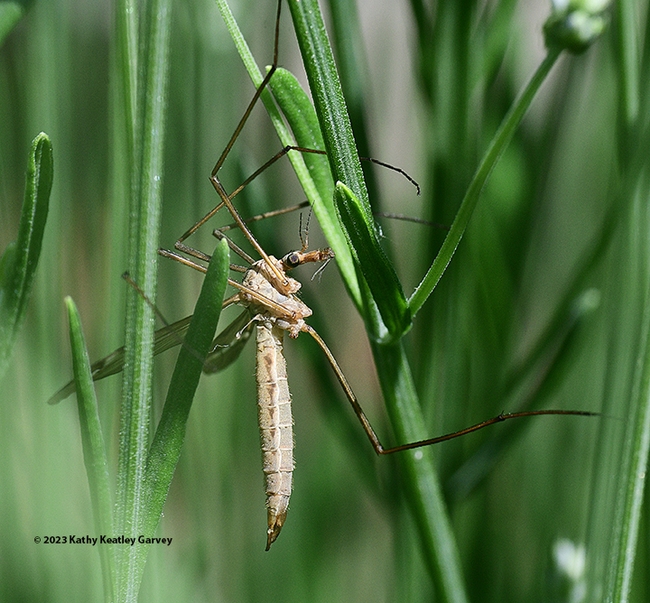
- Author: Kathy Keatley Garvey
Lady beetles, green fruit beetle larvae, and stick-on bug tattoos drew inquisitive and appreciative crowds when the UC Statewide Integrated Pest Management Program (UC IPM) staffed an informational booth at Briggs Hall during the 109th annual UC Davis Picnic Day.
Forensic entomologist Robert Kimsey and doctoral student Grace Horne of the Emily Meineke lab, UC Davis Department of Entomology and Nematology, chaired the department's Picnic Day Committee. (See 'What's a Picnic Without Bugs?)
Lady beetles?
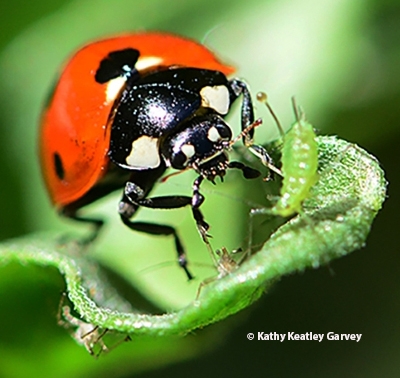
Karey Windbiel-Rojas, associate director for Urban and Community IPM/Area IPM Advisor, said attendees asked scores of questions. "Questions were quite varied but those that stood out were how to control: termites, aphids, caterpillars, ants, carpet beetles, and rats," she said.
Green fruit beetles?
Another popular draw: Green fruit beetle larvae. "They were fun for people to get hands-on with and gave us the chance to talk to people about the difference between look alike scarab beetle larvae," Windbiel-Rojas wrote in an email. "Japanese beetles (which are not established in California), masked chafer beetles (their grubs ARE pests in raised garden beds and lawns) and green fruit beetles (which are not really pests but people sometimes see them in compost)."
"The green fruit beetle (scarab, family Scarabaeidae), is also called a fig eater beetle, green fig beetle, or western green June beetle," according to the UC IPM website. "The adults are an occasional pest of ripe fruits. Adults can fly a relatively long distance and are highly attracted to ripe fruit and the odors of manure and fermenting fruit."
Tattoos?
UC IPM gave away 500 stick-on (temporary) tattoos, including images of the Chinese red-headed centipede (Scolopendra subspinipes mutilans), tarantula hawk (Pepsis heros) and the hickory horned devil caterpillar of a regal moth (Citheronia regalis). They were all gone within a few hours. "Next year we plan to order 1000," Windbiel-Rojas said. Staffing the educational table that included the tattoos were her two sons, Diego, a freshman at McClatchy High School in Sacramento, and Spencer, a seventh grader at Sutter Middle School in Sacramento. As attendees examined and applied the tattoos, the youths talked about invasive pests and the importance of not moving firewood to spread pests.
Meanwhile, at the entrance to Briggs Hall, it was "beetle mania" as members of the UC Davis Entomology Graduate Student Association kept busy selling their beetle t-shirts, the most popular of their insect-themed t-shirts.
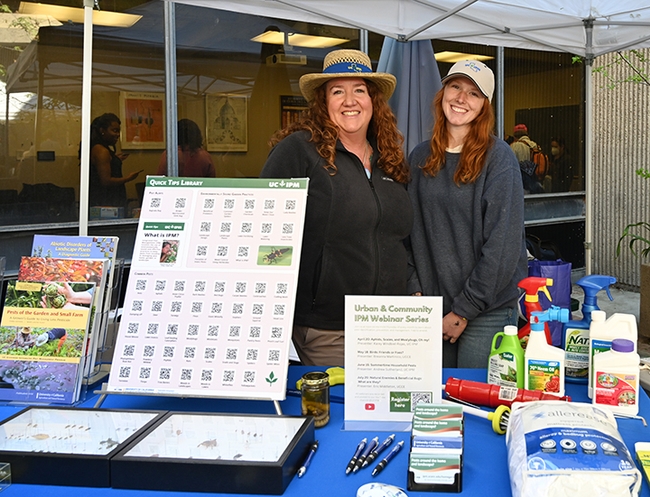
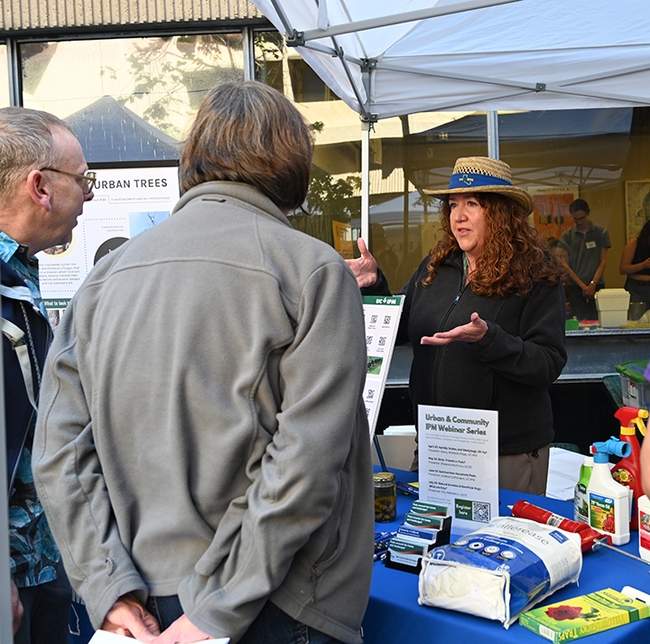
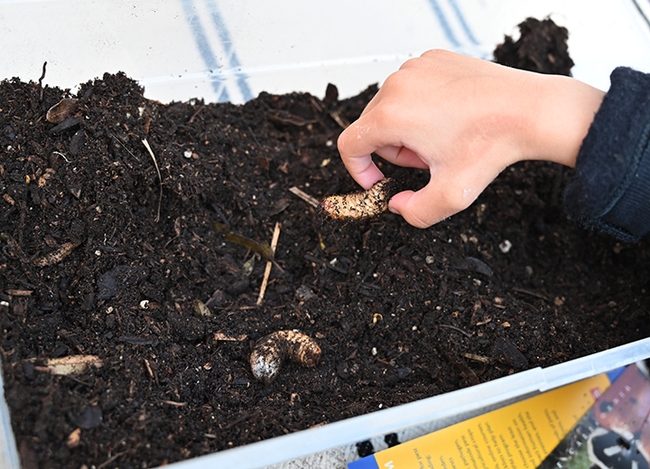
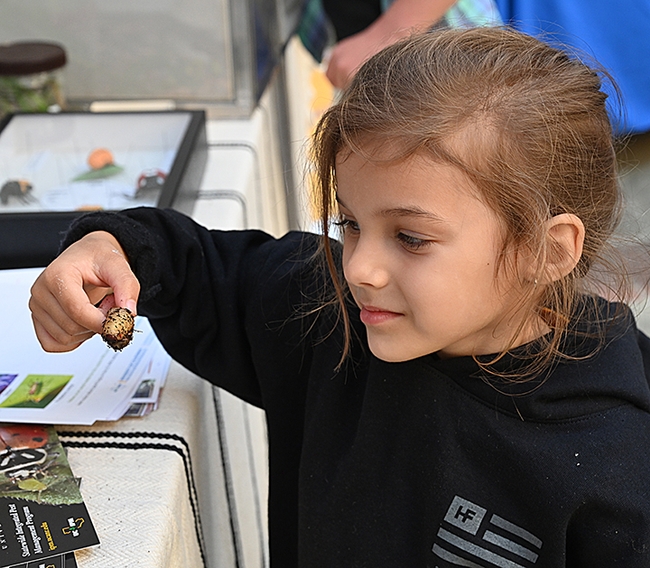
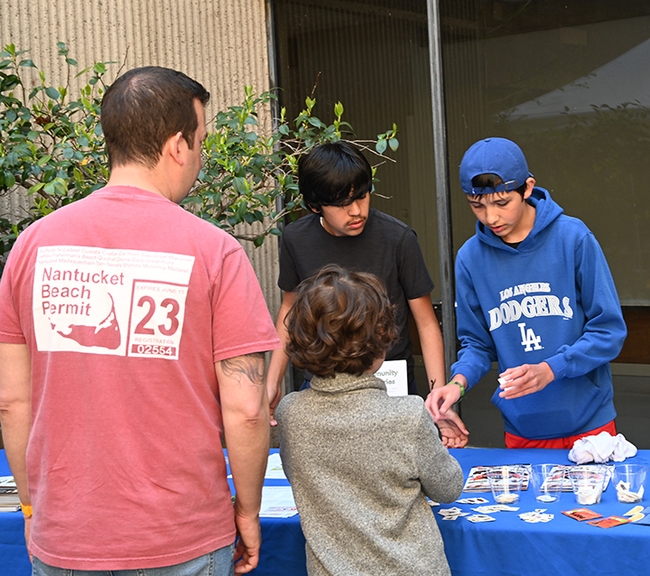
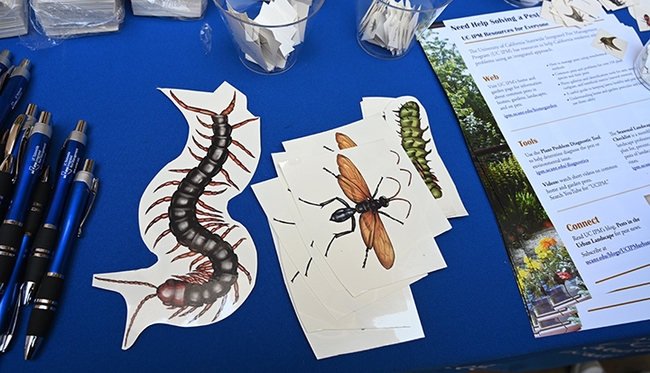
- Author: Kathy Keatley Garvey
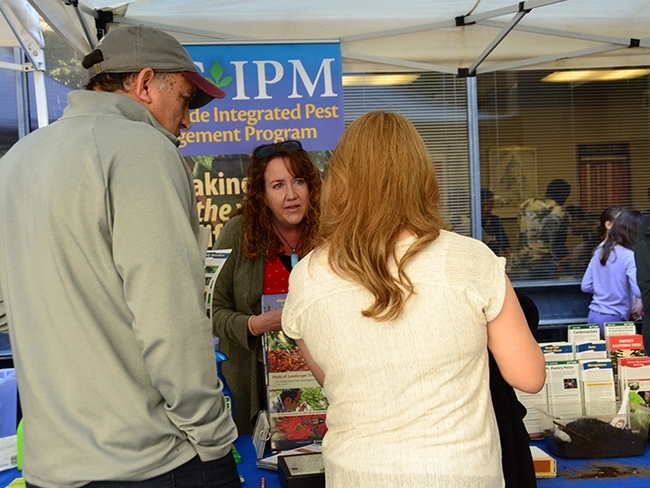
Little kids love selecting lady beetles, aka ladybugs, at the UC Statewide Integrated Pest Management (UC IPM) booth at Briggs Hall during the annual campuswide UC Davis Picnic Day.
The excitement, the capture, the I-get-to-take-these-home-and-put-them-in-my-garden look.
Who doesn't love a lady beetle? (Besides the gentlemen beetles, of course!)
Karey Windbiel-Rojas, associate director for Urban and Community IPM and area Urban IPM advisor, and her colleagues are ready for the crowds that will descend on entomological displays at the all-day Picnic Day on Saturday, April 15, the 109th annual.
The Briggs Hall activities, organized by the UC Davis Department of Entomology and Nematology, include cockroach races, maggot art, forensic entomology, and more. (See Bug Squad blog for events and activities at both Briggs Hall and the Bohart Museum of Entomology)
The UC IPM specialists will provide information information sheets on both endemic and invasive pests and will answer questions.
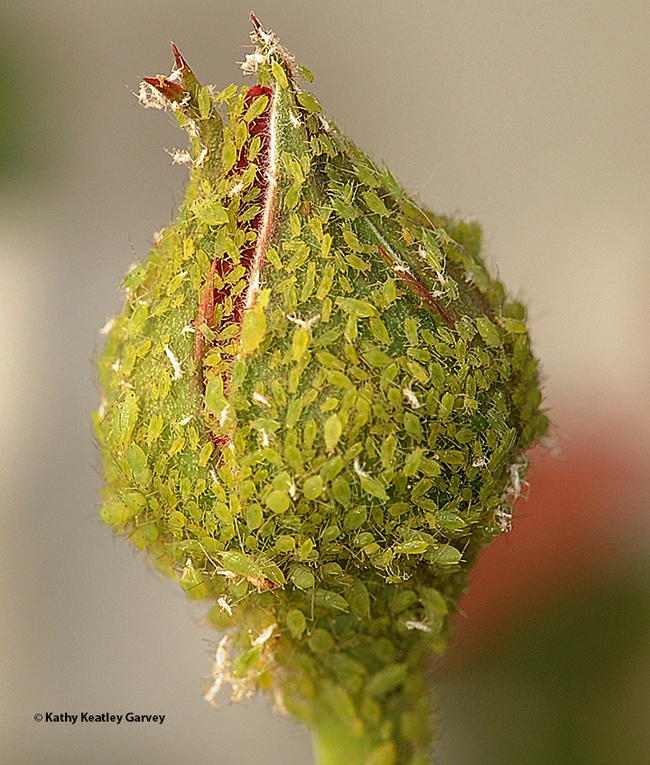
Note that it's not a bug; it's a beetle. Entomologists call them "lady beetles" because this insect is not a true bug. It belong to the family Coccinellidae. Scientists have described about 5000 species worldwide, and about 450 in North America.
"Lady beetles, or ladybugs, are round- or half-dome-shaped insects with hard wing covers," UC IPM writes on its website. "About 200 species occur in California and most are predators both as adults and larvae. Some species specialize on aphids or other groups; others have a broader diet."
Lady beetles, the good guys and gals in the garden, are natural enemies of aphids and other soft-bodied insects. Scientists say a lady beetle may eat around 50 a day, and as many as 5000 aphids in its lifetime. Sadly, the larvae, which look like mini-alligators, are often mistaken for pests.
Don't kill 'em! Treasure 'em!
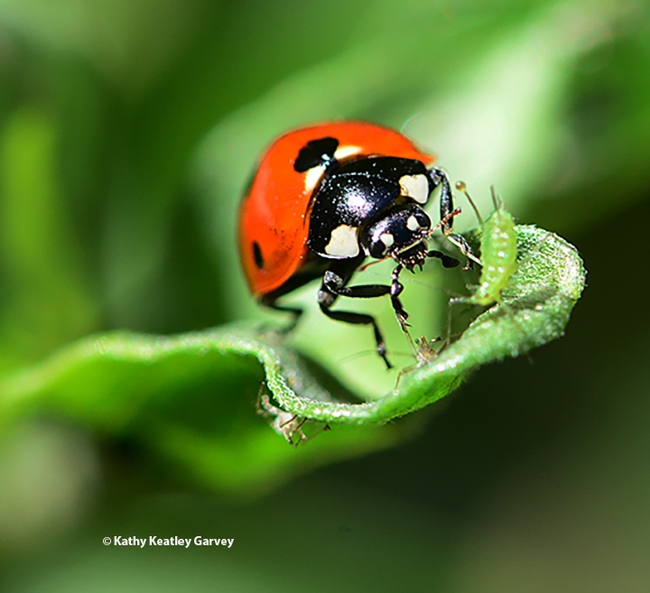
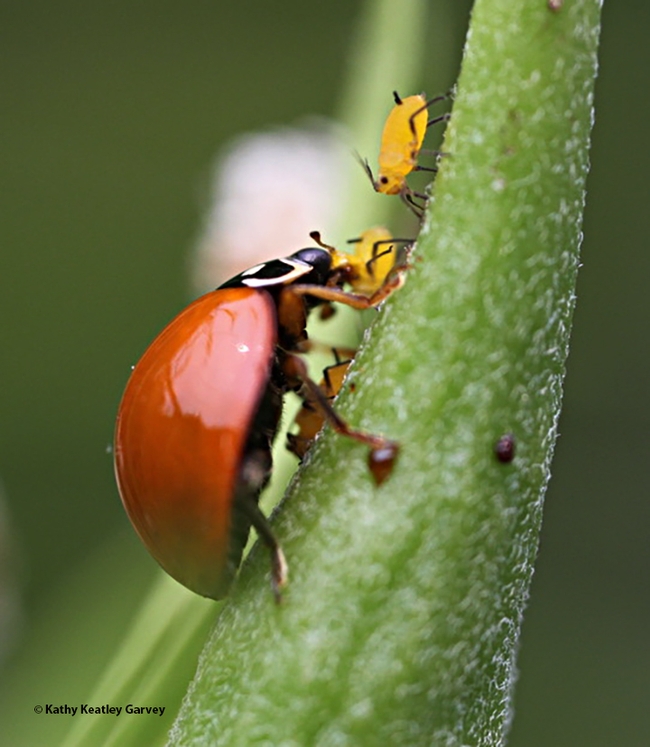
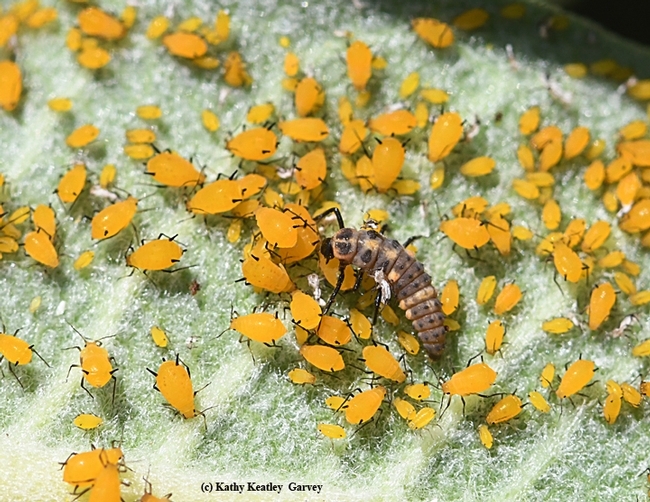
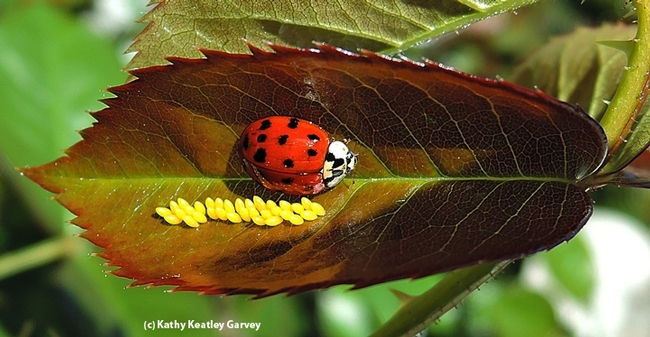
- Author: Kathy Keatley Garvey
It was a good day for a praying mantis.
It was not a good day for a honey bee.
Here's what happened in the "Daily Insect News": a gravid praying mantis, Stagmomantis limbata, ambushed and ate a honey bee on a Mexican sunflower, Tithonia rotundifola, in a Vacaville pollinator garden.
In this image, of a mantis snacking on a bee, do you know which one is a native of the United States and which two are not?
The plant? It's a non-native. It's native to Mexico and Central America.
The honey bee? It's a non-native. European colonists brought the honey bee (Apis mellifera) to what is now the United States in 1622. Specifically, they arrived at the Jamestown colony (Virginia). Factoid: The Native Americans called the honey bee "the white man's fly." Another factoid: California had no honey bees until 1853 when a beekeeper brought his colonies to the San Jose area.
And the praying mantis, Stagmomantis limbata? It's considered native to North America, particularly prevalent in the southwestern United States. Commonly known as "bordered mantis, "bosque mantis," "Arizona mantis" or "New Mexico praying mantis," it is green or light brown and can reach three inches in length, according to Wikipedia.
We've seen mantids snag not only honey bees, but monarchs, Western tiger swallowtails, Gulf Fritillaries, skippers, syrphid flies and long-horned bees.
Never once--not once--have we seen this species grab and dine on a stink bug, milkweed bug or lygus bug.
Maybe a little menu planning is in order, Ms. Mantis? Maybe you should check out the UC Statewide Integrated Pest Management Program site to determine which is a pest and which is a beneficial insect?
Nah, just kidding...everything in the garden must eat to survive.
